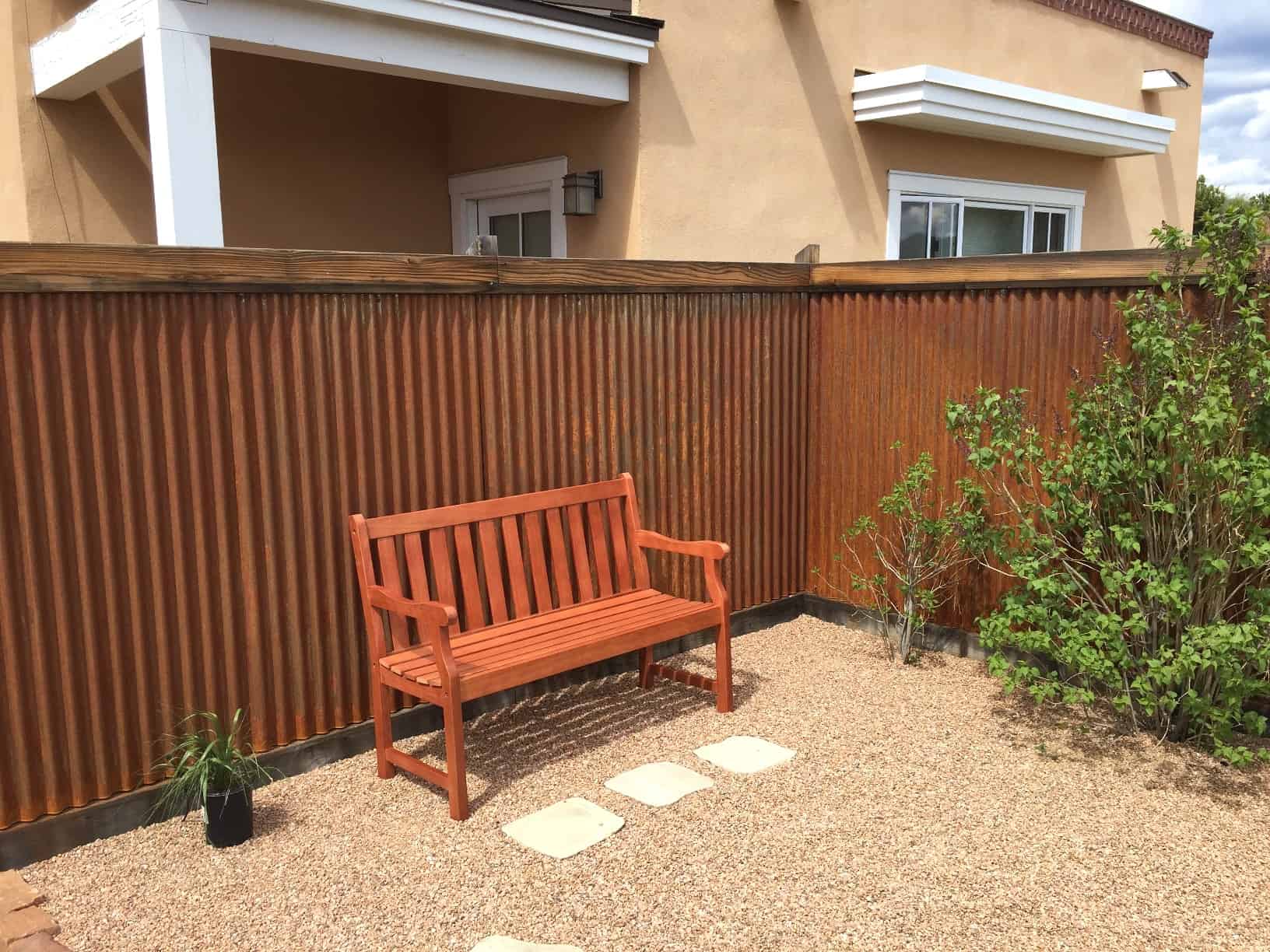
Our master bedroom garden was an unsightly mess. What it needed was an instant rusted corrugated metal fence, although it took me a while to figure that out.
The space was initially designed as coyote-safe place for our small dogs and a sunny location for our raised bed gardens in galvanized stock tanks. But the native grasses had taken over, and the heavy-gauge open mesh fence offered no privacy. It was time for a serious landscaping remodel.
Bee Zollo, my life partner, and I decided we wanted a space with a cleaner, more modern aesthetic than the over-grown “natural” look that we currently had. The most important element in the new garden was making it more private. This necessitated replacing the open mesh fencing with a new design. We considered a range of wood options, but finally decided we liked the contemporary appearance of a rusted corrugated metal fence using the existing redwood framing which was in very good shape.
Inventing the Instant Rusted Corrugated Metal Fence
Adapting the framing to mount corrugated steel panels was relatively straightforward. But getting the rusted look was the challenge. Unfortunately, finding bare corrugated steel in our locale (Santa Fe, New Mexico) was not easy. It is not a stock item in our local big box stores.
After a bit of web-searching, I discovered a metal retailer in Arizona that could not only cut my 37 pieces to a precise length but would deliver it to my doorstep. (A word of warning to the budget-sensitive—just the raw metal for the fence came out to $2.50 per square foot of fence area.)
Once the bare corrugated steel was on order, the next test (and the real reason for this story) was determining how to accelerate the rusting process. Bare steel has a harsh industrial look, and I was concerned about the unpleasant appearance as natural rusting took several years to complete in our high-desert environment.
I headed back to the web, where I found a couple tutorials on how add a rust patina to small objects. But there was nothing about scaling the process up to handle 1,000 square feet of bare corrugated steel surface area (both sides of the panels). I needed to develop my own recipe to make this project feasible.
Need a Dependable Chainsaw that Always Starts–Every Time?
The Greenworks 40v Cordless Electric Chainsaw has a brushless motor that delivers up to 30 percent more torque for impressive cutting performance.
The motor is quiet, runs smoothly, and starts with the push of a button. Say goodbye to smelly gas fumes and hard-to-start gas-powered motors.
Up to 70 percent less vibration for user comfort. Chain brake and low kickback chain for increased user safety. Electronic chain brake prevents accidental kick-backs.
Comes complete with a battery pack and charger that is fully compatible with other Greenworks G-MAX 40V cordless electric tools.
Check Price on Amazon.
The Recipe for This Amazing Metal Fence
The basics of how rust forms is basic high school chemistry. Rust is an iron oxide that is formed when iron and oxygen react with water and/or moisture in the air. Better still, the process of creating “instant rust” is easy and rather fun—especially when you get to the last step. The materials are easy to find and the process is relatively simple and quick.
Materials
All it takes to create the “rust” part of an instant rusted corrugated metal fence is some inexpensive household chemicals, a metal cleaner and a decent weed sprayer. Specifically, you will need the following materials:
- Degreaser: I used Zep Fast 505, but any industrial strength degreaser should work. Applied undiluted, I used three gallons for my project.
- Vinegar: Buy this at your local grocery or hardware store. (We use vinegar for general household cleaning). Apply it undiluted. I used 3-4 gallons for 1,000 square feet.
- Salt: Just plain old table salt is fine.
- Hydrogen peroxide: This is available at all drug stores. Depending on the size of your project, you will need a lot of this and it’s not easy to find in gallon containers. I would estimate one gallon for every coat on 250 square feet of corrugated metal. Yes, this is a lot of the pint-sized containers typically found at drug stores. (One-gallon bottles can be ordered online.)
- Weed sprayer: The picture below shows the inexpensive, one-gallon Home Depot brand sprayer I bought for this tutorial and some touch-up work on my fence. If your project is more than a couple hundred square feet, I spend a few bucks more for a better, two-gallon sprayer with a metal tip that lets you control the spray pattern. A nice fan pattern is much better than the random pattern that cheap sprayers deliver. As a side note, even though these chemicals are relatively mild, they can destroy a sprayer if it has metal components. So, consider the sprayer a project cost.
- Piece of wood: This short piece of cedar is in all the pictures to demonstrate that the application of these chemicals only minimally changes the coloration of this species of wood. Other types of wood may react differently.

The “Instant Rust” Process
The process of creating the “instant rust” part of your instant rusted corrugated metal fence takes many steps. It begins with degreasing, followed by etching, and then the instant rusting steps. Our test panel started out as a leftover piece from my project. It sat in the garage for several weeks and only picked up a tiny spot of rust in the top right corner.
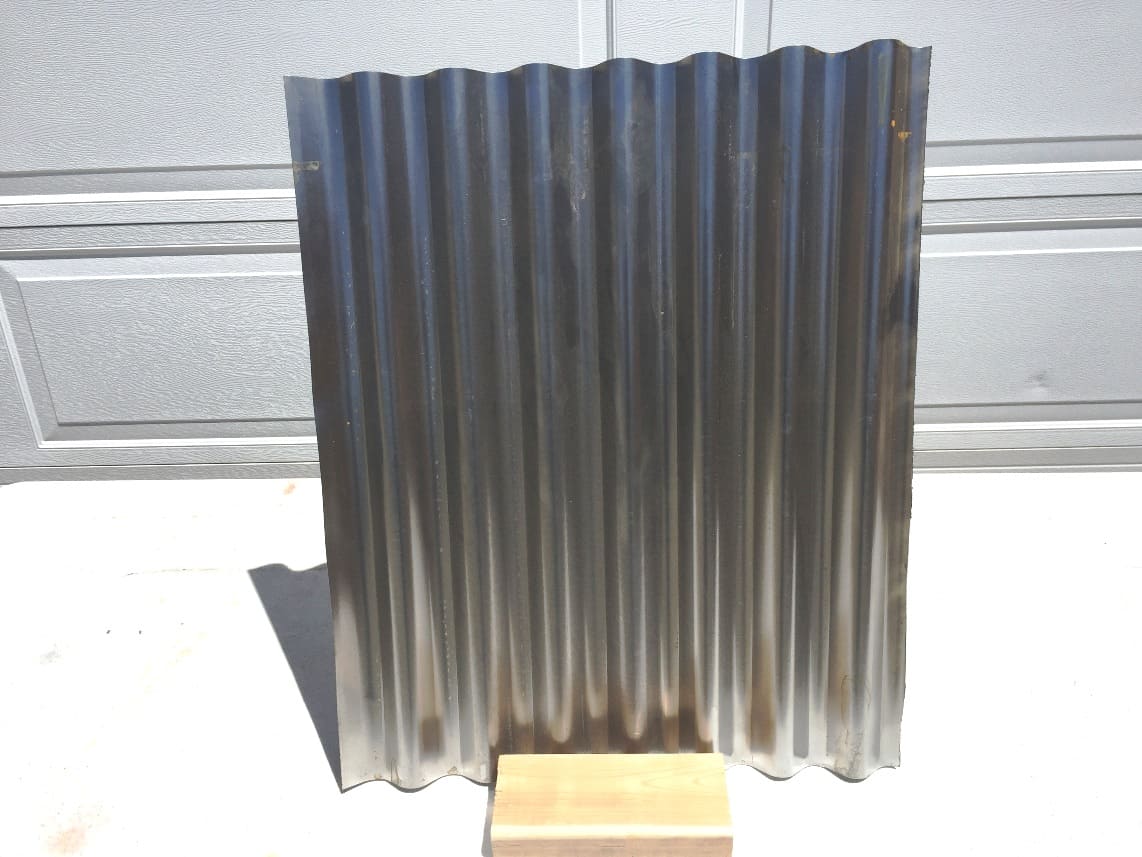
Degreasing
It is important to follow the instructions for your degreaser. The Zep material was sprayed on and then rinsed off after 1-2 minutes. Do NOT try to degrease your whole project in one spray session unless you can finish all your spraying in one minute and immediately start rinsing. It’s best to do this in smaller sections.
Let the surface dry before proceeding to the next step. The degreased panel shown below is a bit shinier after cleaning. The degreaser removes minor films of dirt and oils that might affect the next steps.
Etching
This step uses the acetic acid in vinegar to start the oxidation of the metal, which is essential to rusting. Do NOT skip this step or try to conserve vinegar. The vinegar is inexpensive, and etching the metal with vinegar is an important step. Spray it on and let it dry without rinsing. Visually, the etched panel has not changed noticeably.
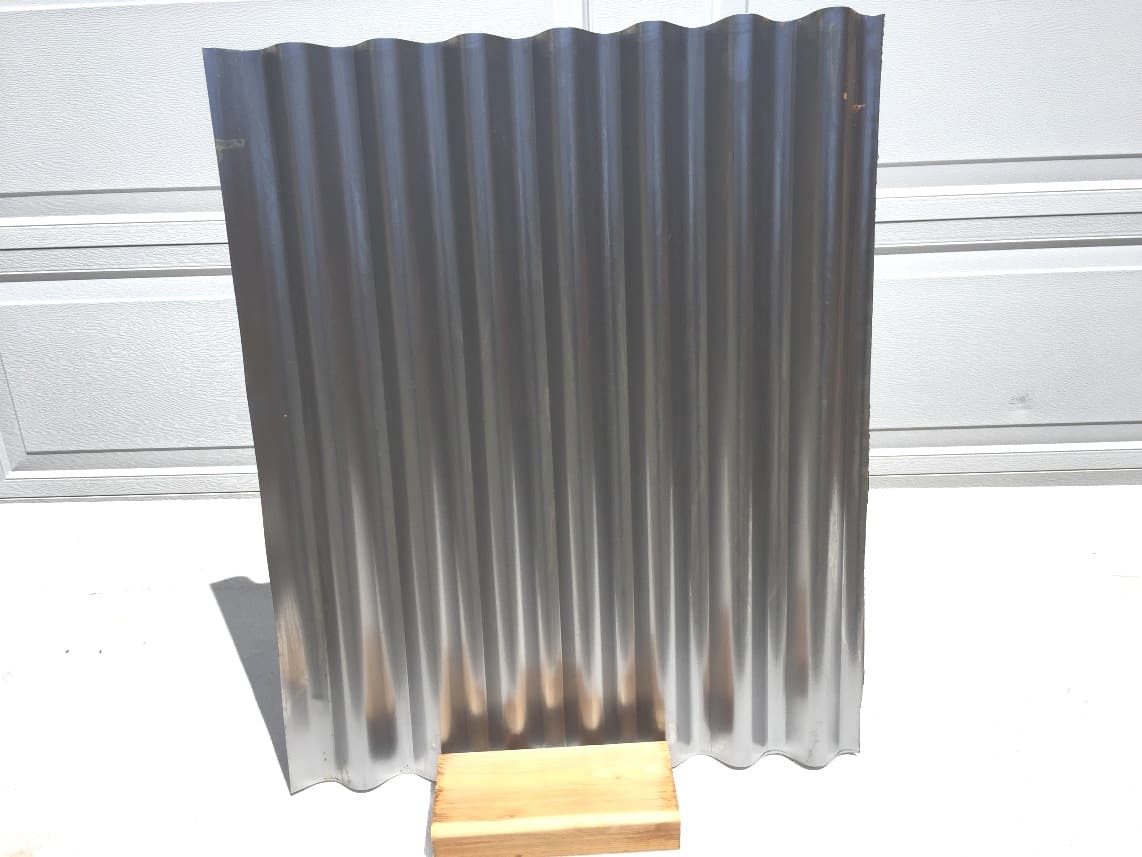
Rusting
Now we get to the rusting part of the instant rusted corrugated metal fence. This is my favorite part. Mix up the rust accelerator solution in 8:1:1 proportion. For every eight ounces of hydrogen peroxide, add one ounce of vinegar and one teaspoon of salt. Stir or shake well so the salt is fully dissolved. This is very important, since salt is critical to the rust acceleration process.
Spray on the solution and you will see rust form the moment it strikes the metal. Instant rust! Apply as uniform a coat as possible, but you will likely have bare spots in your first few sections. Not to worry, since this can be corrected with subsequent coats or touch-up spraying. Below is the panel immediately after the first spraying. Notice the foaming action.
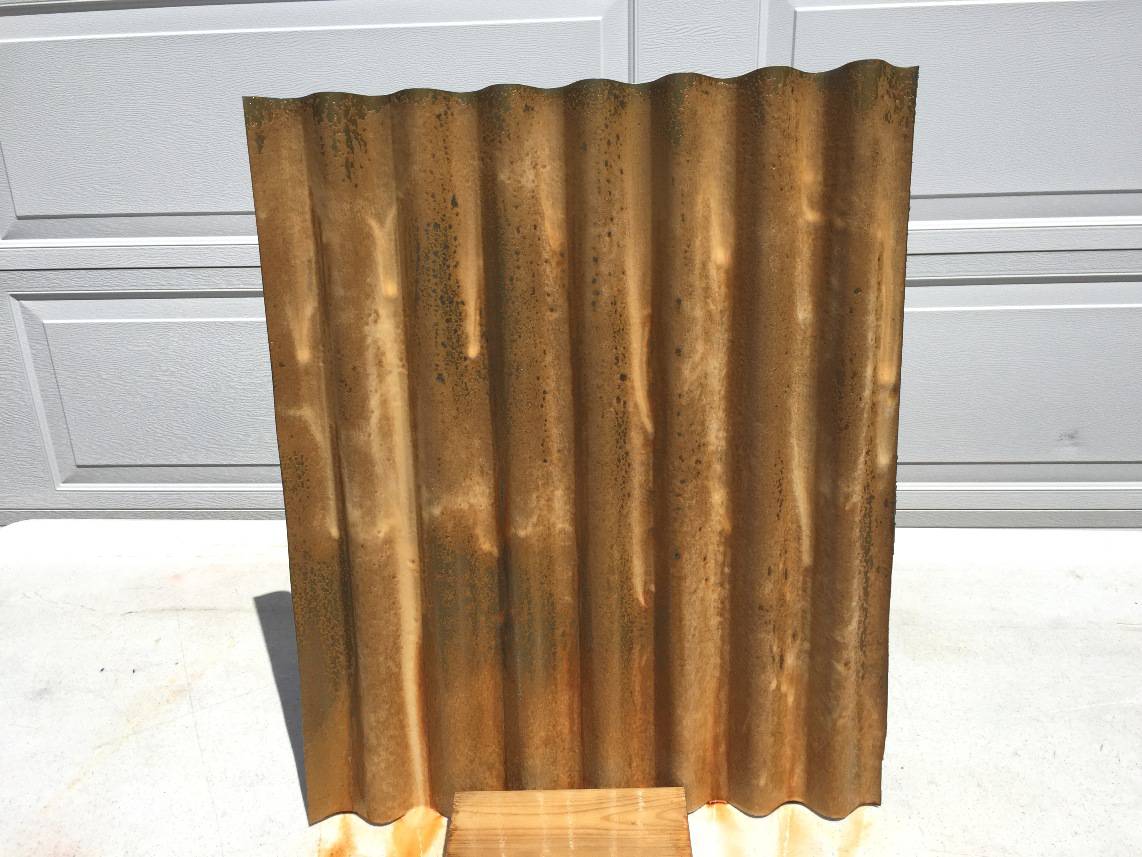
After drying, the panel looks amazingly rusted. However, there are a few spots that didn’t rust thoroughly, and the rust is not uniform.
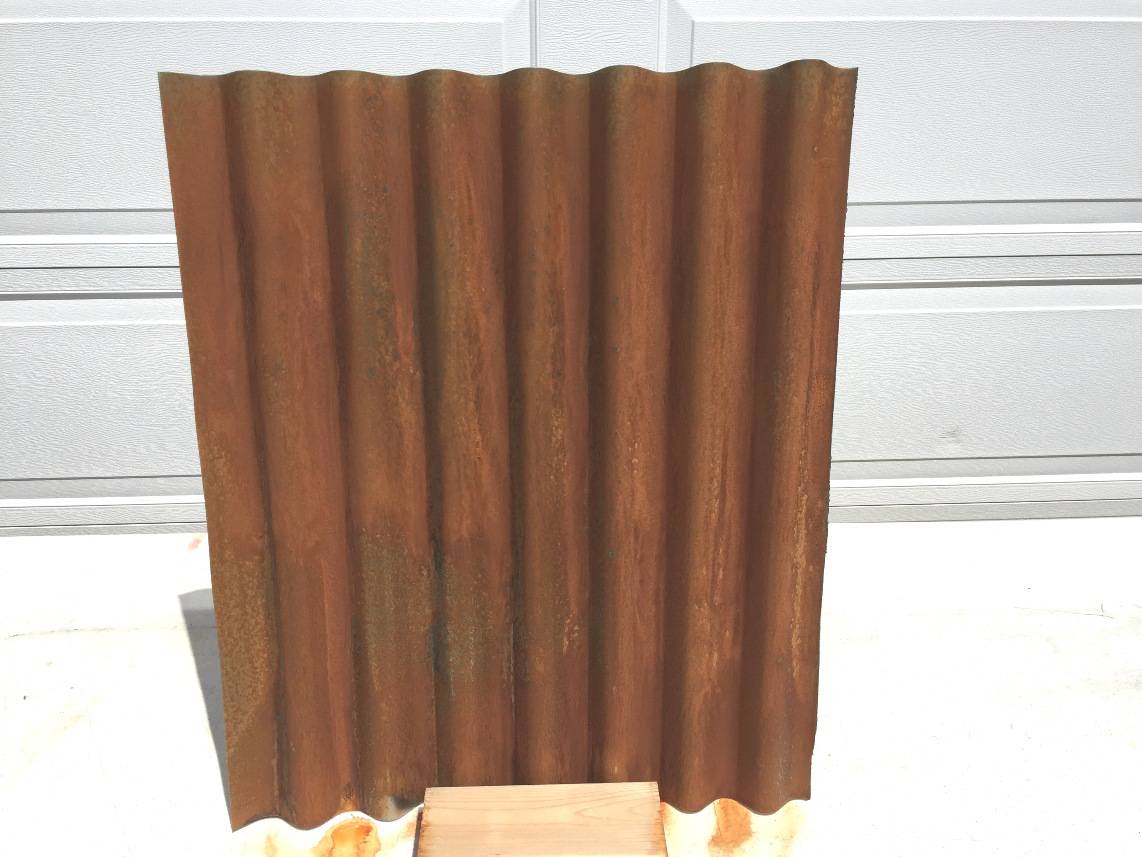
To improve rusting coverage, a second coat of the rusting solution was applied and permitted dry. Now, the color is much more uniform. (NOTE: You may also be able to get this “second coat” look simply by doing a touch-up spraying after the first coat.)
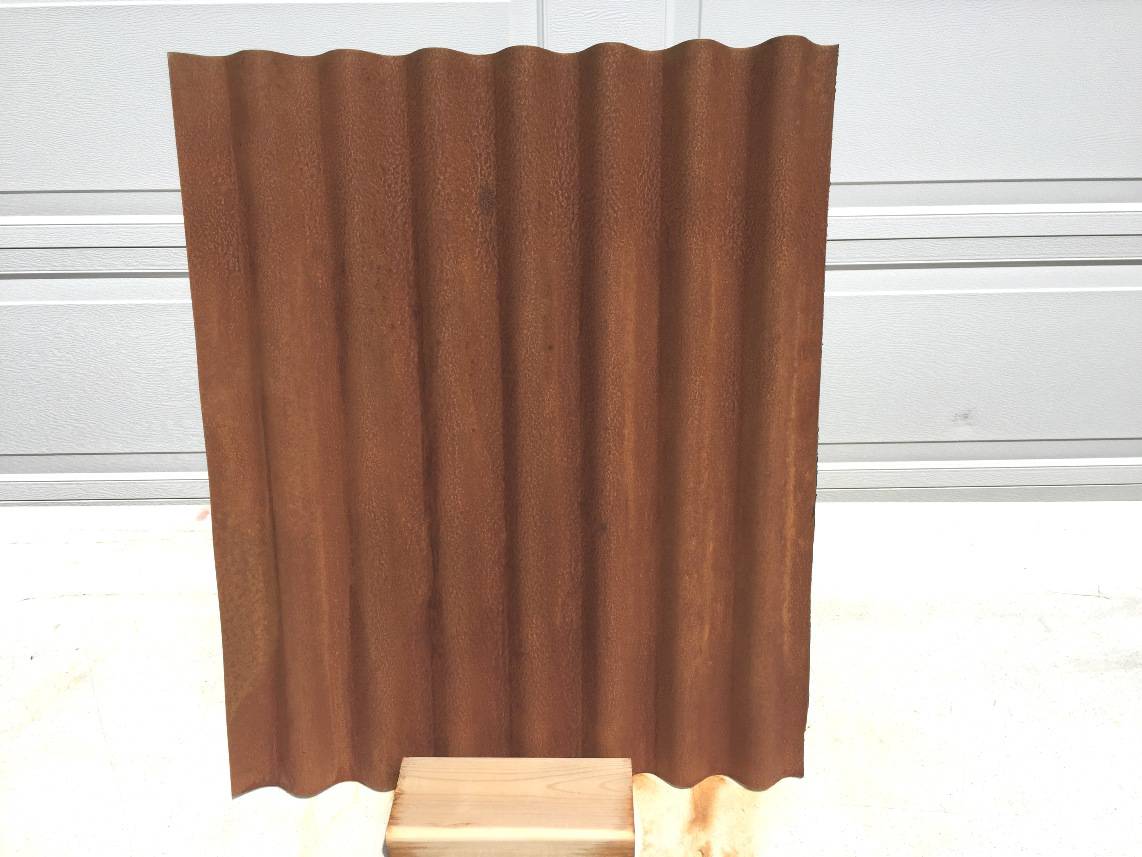
My Instant Rusted Corrugated Metal Fence
After less than a month, I am really pleased with the results of my instant rusted corrugated metal fence project. My actual fence is only a one-coat effort, which I will touch up in several places as the landscaping portion of the project wraps up.
Even if I do nothing, I expect the rust coat will naturally develop a more uniform appearance over the next year. I think it’s worth 30 minutes of mixing and spraying to accelerate the process nicely.
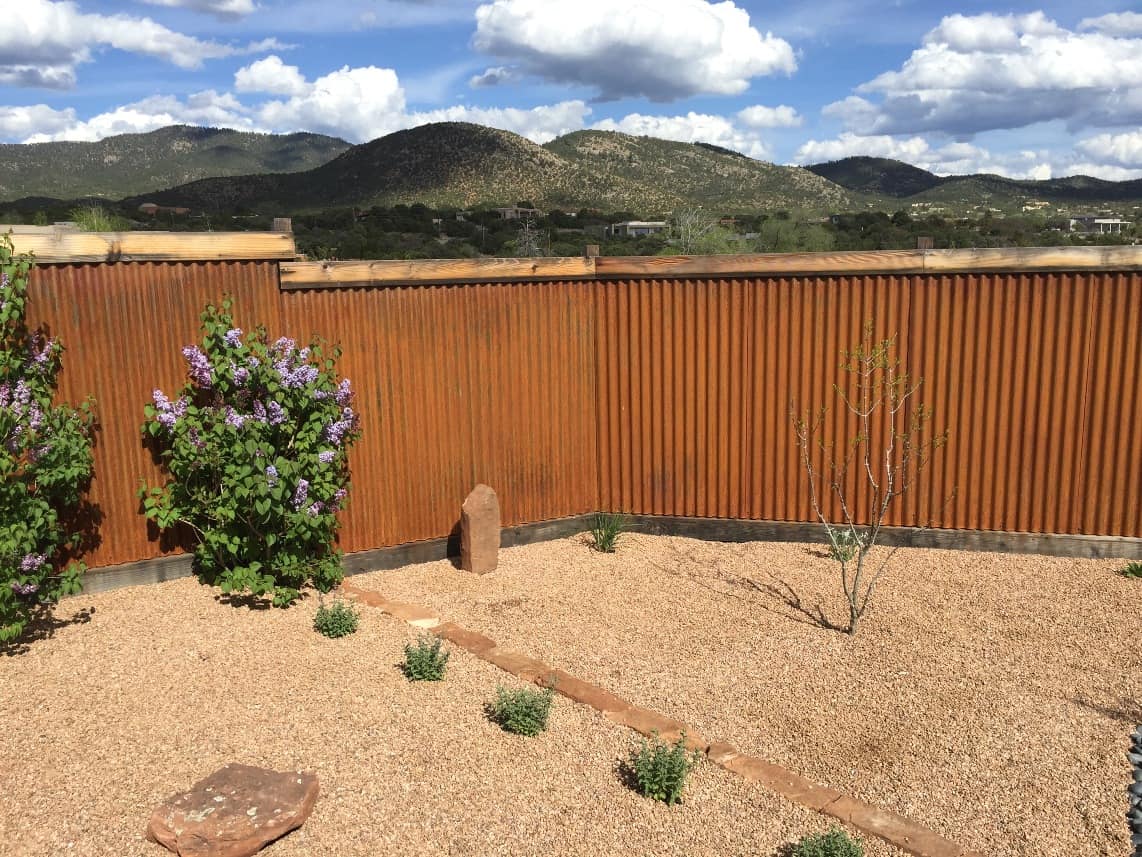
Bonus Tips for Your Metal Fence
- Common sense safety is the most important factor in an instant rusted corrugated metal fence project. Even though these household chemicals are mild solutions, wear gloves and eye protection.
- Do NOT buy Corten-branded corrugated steel if you use this process. Corten products are at least 25% more expensive than bare steel and the rust acceleration process described here delivers a similar result. If are patient and would rather not deal with the “instant rust” process, by all means consider Corten corrugated metal. It is manufactured to deliver a nice uniform rust coating in as little as six months with minimum fuss.
- The test panel in this article received three coats of the rust accelerator solution. For small projects or impatient folks, three coats might make sense. For larger projects, I would recommend a good first coat with coverage as complete as possible. After that coat dries, hit the bare spots with more rust accelerator solution and then give it a few weeks or months to see how it looks. Touch up again if necessary or know that time is your friend in this process. Unprotected steel in an outdoor environment will rust eventually.
More Tips for Your Rusted Corrugated Metal Fence
- In my project, I diluted the rust accelerator solution by adding water in the same amount as the hydrogen peroxide and doubling the salt. It left bare spots which I plan to touch up. So, if you decide to use a diluted solution, plan on doing two coats of spray. I think the best approach is to use the proportions I outlined above for the first coat and do a bit of touch up spraying. It saves time and uses about the same amount of hydrogen peroxide.
- Do NOT try to use galvanized panels to save money. This process WILL NOT WORK on galvanized surfaces for the obvious reason—galvanization is a rust inhibitor.
- If you are tempted to let nature take its course in rusting the metal panels, plan to be very patient. The picture below is the backside of a section of the fence that wasn’t treated. After a month, very little rust has formed—even after several spring rain storms. This section is somewhat protected and does not receive direct sunlight, but the complete lack of rust suggests there may a light film of oil from the rolling process that is protecting the surface. Over time I’m certain it will rust nicely, but it could take a couple years.
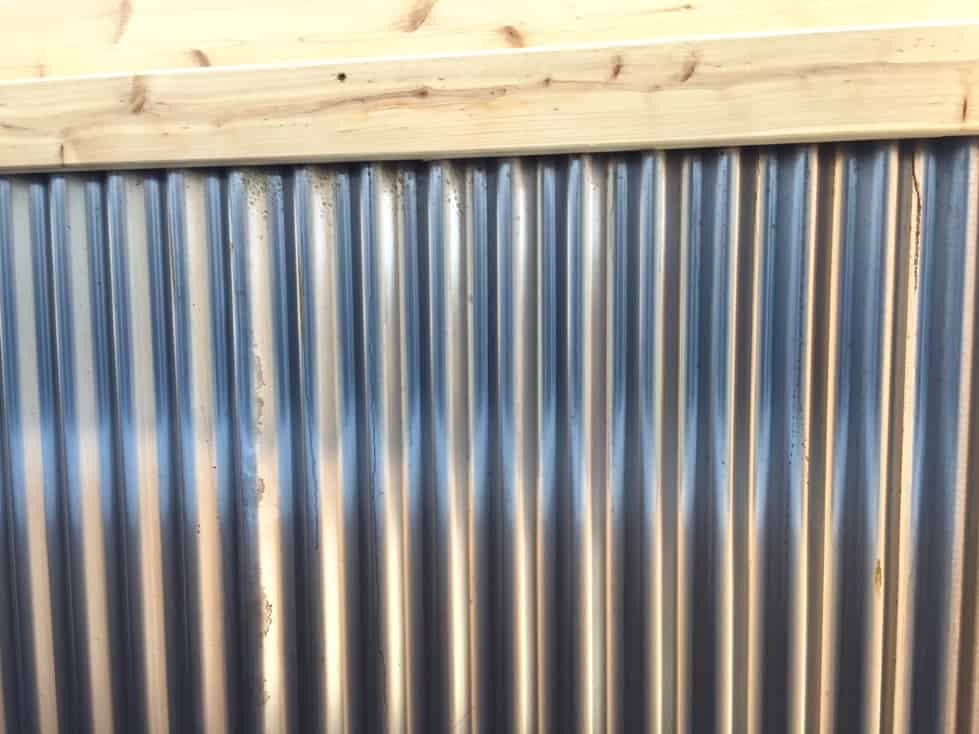
That’s it! Enjoy your Instant Rusted Corrugated Metal Fence, and please leave comments and questions below. Click here for Other Fence Ideas.


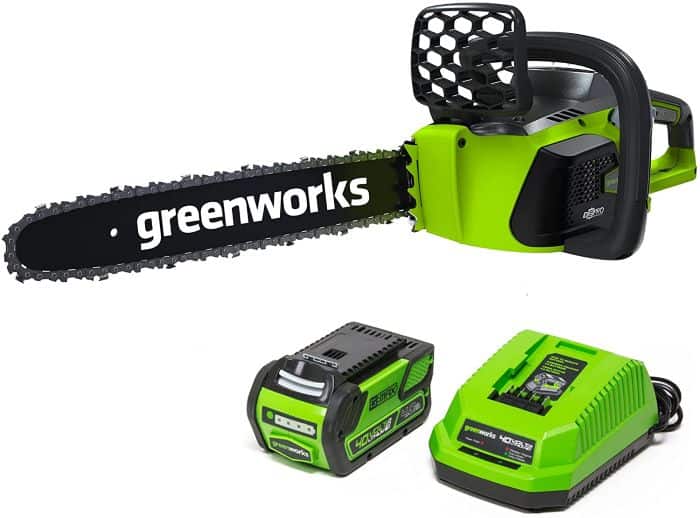

Thank You for the detailed article about rusting corrugated metal for fencing. Before starting a fence like this, I have one last concern.
What has been your experience regarding the noise level during a heavy rain whacking the fence at an angle?
K.S. — I asked Gary Ebersole about this, and here’s what he said: “We have some heavy summer monsoon rains in Santa Fe, and we’ve never had a noise problem from rain. The angle of attack for the rain would need to approach near horizontal at wind speeds in excess of about 40 miles per hour to make any noise. Plus, you would need to be outside near the fence (in the rain!) to hear it. So don’t let “noise” deter you from installing a corrugated metal fence.”
I love this article about rusting a metal fence. We are looking into installing one soon. I am also interested din how the actual fence was installed!? Is there concrete at the base and wood at the top? Is there instructions anywhere? I love the appeal this has.
Thank you
Here’s what Gary said in response:
Our rusted metal fence began as a different style of fencing that used 4” mesh (the mesh wire was 1/4”). For all practical purposes, I just replaced the mesh with the corrugated panels before using the rusting procedures. The fence framing uses the typical technique of setting 4×4 posts in concrete 6’ on center (8’ could also work if you use 2×6 rails). In my case, I used 2×6 horizontal rails at the top and bottom and then attached a 2×4 on the back side of each rail projecting about 1-1/2” into the open space to provide a place to secure the corrugated metal sheets. My fence is a bit more decorative than the basic, picket-style cedar fence. The raised border frames the recessed panels giving it a bit more formal, picture-like appearance. I’m thinking of lopping off the top of my posts to provide a cleaner look.
For a sleeker, more modern appearance, the rails could attached so the face is flush with the post. Attach the corrugated panels to the face of the rail so that all that is showing is metal. Have your supplier cut the panels cut to a length so that the panels projects an inch or two above and below the rails. You can also shorten the post length so the post is not visible. With this style, all you will see is the rusted panel material.
I would recommend a bit of Google research on fence construction. Once you understand the basic principles, then consider modifying a design to meet your styling preferences. As an important side note, my fence and the more modern design I suggested here are not necessarily “good neighbor” fences since the best side faces in. We have no close neighbors so nobody is offended but you should give some thought to how it looks from the outside. My design looks fine albeit it a bit busy with the exposed posts and rails.
One more thing: This is a pretty good article about basic fence building: https://www.instructables.com/id/Build-a-Wooden-Fence-and-Gate/
Gary
Hi,
Beautiful fence! Would you be able to share where in Arizona you ordered the custom sized panels?
I am looking for something similar.
Hi Dennis–
Gary Ebersole ordered his metal fence panels directly from https://www.cortenroofing.com/ (same company as https://www.westernstatesmetalroofing.com/). Many local metal roofing suppliers in the West use the same source. Gary says they were very easy to work with. Good luck with your fence!
Randy Schultz
Hi all,
Found your article while searching how to rust corrugated metal. Been looking forward to this project for several months, so I finally discovered a place on my property where the fence would “fit”. Ran off to Home Depot, grabbed 2 12’ panels and tore right in. Much to my dismay everything you can get in NC has a galvanized coating on it.
I was distraught (for all of 30 minutes!) discovered that you can remove the galvanized finish from the panels using a couple coats of muriatic acid (also available at Lowe’s, Home Depot or Menards). Be sure to wear protective gear as the smoke from the reaction is quite unpleasant (only do it outdoors in the sun) and wear a mask! However, as you spray the muriatic acid on you begin to see the galvanized coating break up and reveal the steel underneath. Once you’re done with the muriatic acid be sure to wash it off with water thoroughly, then follow the instructions on this site and viola! Magic rusting! Thanks for the detailed article with pics, can’t wait to show off and enjoy my new rusted fence!
Mike R.
Concord, NC
Mike–
Thanks for this great update. And thanks for including the safety information. ALWAYS be safe when you are using acids and other toxic chemicals!
— Randy Schultz
Hi there,
Great article. This is just the look we are after. If you’ve used the muriatic acid to remove the galvanized finish, do you still need to use the degreaser as the next step?
Cheers,
Laurie
Hi Laurie–
Here’s a response from Gary Ebersole: Muriatic acid is apparently not a great degreaser but it doesn’t seem likely that there would be any grease under the zinc coating. I would do a test run of “instant rust” on a section of the de-galvanized steel to confirm all the zinc coating is removed. Do a test on another section with a degreaser applied first. That should help you determine whether a degreaser is necessary.
Man! I have ever seen such an elaborated post on instant corrugated metal fence… Thanks for investing time to create this and share it with the world. Thanks for sharing these great and practical tips… great post!!
Re white vinegar – what acidity % is recommended? I’ve seen 5%, 20% and 30% acidity. Wouldn’t higher acidity work better for this purpose?
Rob–
Gary Ebersole recommends you buy the cheapest vinegar you can find, which is typically the cleaning vinegar from the “big box” stores. Paying more for expensive vinegar won’t give you better results for this project.
Thanks for posting this useful information here. I really hope it will be helpful to many to know how to build an instant rusted corrugated metal fence. Appreciate the content!! I loved reading this article, and I love your website.
From this article you will get to know about building an instant rusted corrugated metal fence. I enjoyed reading this article as it provided me lots of information!
This story is a great source of information! I think it will be helpful for lot of people (like me) who are looking to build an instant rusted corrugated metal fence. Thank you very much for sharing this article, this is really helpful for me, thanks again and looking for more great stories in the future!
I live in Tucson with its blistering hot summers. I am concerned that a solid metal fence will significantly increase the heat factor in an enclosed space. Any thoughts?
The color, mass, and height of the fence as well as the size of the enclosed area will determine whether this is a problem. A dark, wooden fence with minimal permeability for circulation would probably retain as much heat as a corrugated metal fence. A concrete block wall is high-mass but if the color is lighter, it would probably be a bit cooler. If you have decent circulation, I would guess all fence types have a similar impact on the yard temperature.
I just ordered my 22-gauge 7/8” Corrugated metal roof panels and accessories from Metal Depots in ABQ. Kevin Sanchez had Rustic C in stock. Then I had to find a roofer that did metal roofs. After installation, I wanted to put a weathered patina on. This is a great article and recipe to weather it. Much safer than Muriatic Acid and it is fast. As is noted you don’t need Courten brand.
Thanks Gary for the recipe, your fence looks great!
Hey, my son and I just “rusted” 60 panels of 32″ x 60″ Rustic C panels following the formula. It was super cool and easy. We followed the formula exactly. Really appreciate ya’ll posting this info. We are building an outdoor “Om + Bio-Alignment Lounge” at our small new place in Lockhart, Texas. Needed privacy as it’s a naked lot in the city. Appreciate it.
Jon
Thanks for the kind words, Jon! We’re glad you enjoyed this story. Please tell your friends about HomeGardenandHomestead.com!
Nice looking fence and good report on how it happened. Looked briefly on Amazon for hydrogen peroxide and saw gallons available in a 3% solution and a 12% solution. I’m curious what you used and/or recommend. Thanks in advance.
It took me a long time, but I finally found a source for NON-GALVINIZED corrugated sheets. It’s in Southern California and I had it shipped to Nor Cal. http://www.costametals.com. There website has lots of examples of their work. I have a couple hundred feet of wood fencing that I need to replace due to the increased risk of fire in California. Big project.
Love you article. What truly intrigued me was that you are also located in Santa Fe,NM. We just moved here and thinking about fencing options. Wondering if you have any insights as to how to attach the corrugated metal to existing stucco columns. We have a few of them and my thought was to place the corrugated metal in between the columns. I’m thinking we might have to attach the metal to a wood frame and then attach the frame to the column. Just wondering.
Jez–
Here are some comments from Gary Ebersole:
It should be straightforward to build a simple 2×4 frame that attaches to the stucco columns, which are likely to be constructed from concrete blocks. I would be inclined to attach the framing to the columns first and then attach the metal to the frame. Manhandling a pre-built frame and metal could be challenging depending on the dimensions. It would be heavy, awkward, and requires that you are spot on with your dimensions. It’s at least a two-person job. Framing first and then attaching metal can be done by one person.
In terms of framing style, you could either hide the frame completely on one side with the framing exposed on the other side. Or you could recess the metal inside the frame with 2×2 cleats attached to 2×4 framing members. Or, for a really clean look, you could use 2×8 framing and 2×2 cleats on each side to secure the metal. It’s an aesthetic choice as well as structural since the span between columns is important.
No matter what style you choose, secure the frame solidly to the columns with Tapcons and attach the metal to the frame using screws no more than 10-12” on center depending on screw length. As with all solid fences, they are like sails (in the wind) and generate high loads. I had several panels come loose during heavy windstorms in places where I was didn’t use enough screws. Much better to spend more time installing a few extra screws on a quiet day than trying to secure a 5’ section of sheet metal in 40 mph winds.
That is a killer fence, awesome article and great wisdom and knowledge which took some time to arrive at building that beauty. One question on that cedar running across the top was that that stained, blackened with a torch or just the natural elements and time that give it that beautiful rustic color? Thanks for a super article and some great inspiration!! Rico
To those of you who wanted more information about the metal panels and where to buy them. Gary Ebersole offered this info.
Metal panels are available here: https://www.westernstatesmetalroofing.com/
This is the Corten which rusts evenly without treatment. More expensive.
https://www.cortenroofing.com/7-8-corrugated-corten-roofing-a606-4-weathering-steel-panel.html
This is the bare steel I used with my treatment.
https://www.cortenroofing.com/bare-cold-rolled.html
Gary Ebersole
This article provides a unique and creative approach to fencing. The idea of an instant rusted corrugated metal fence is intriguing and adds rustic charm to any property.